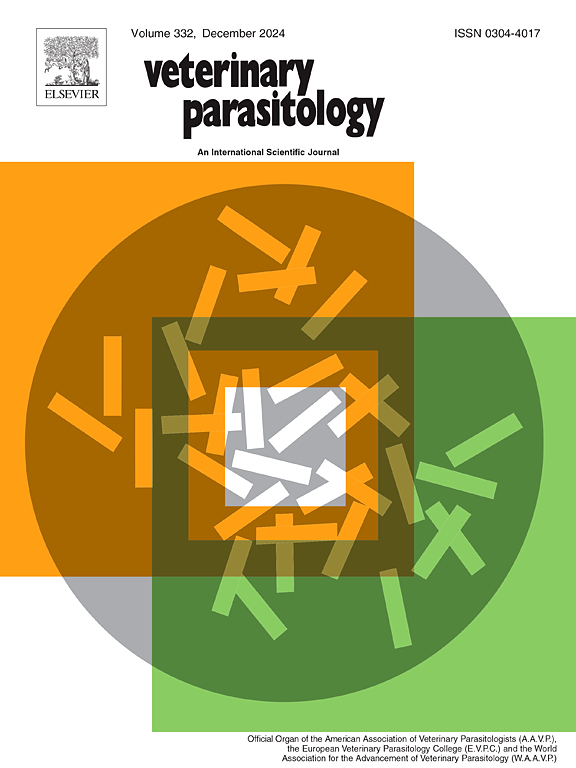Characterization of cyclophilin 23 as a novel factor for development and pathogenicity of Cryptosporidium parvum
IF 2.2
2区 农林科学
Q2 PARASITOLOGY
引用次数: 0
Abstract
Cryptosporidium parvum (C. parvum) is a common zoonotic protozoan pathogen that can cause severe diarrhea in both humans and animals. However, the factors involved in its pathogenicity remain incompletely understood. The C. parvum genome contains nine genes that encode peptidyl-prolyl cis/trans isomerases (PPIases). Previous bioinformatics analyses have indicated that proteins within this family may be associated with the pathogenicity of C. parvum. Here, we explored the role of cyclophilin 23 (CpCyP23), a member of the PPIase family, in the development and pathogenicity of C. parvum. In this study, the CpCyP23 gene was tagged and deleted using CRISPR/Cas9 technology in C. parvum. Immunofluorescence analysis demonstrated that CpCyP23 is expressed in all key developmental stages of C. parvum. The impact of CpCyP23 deficiency on parasite development and pathogenicity were assessed in HCT-8 cells and interferon-γ knockout mice, and the results revealed that the lack of CpCyP23 delayed the development of C. parvum in vitro. Moreover, compared with mice inoculated with the tagged strain, those infected with the knockout strain exhibited a reduction in parasite burden and small intestinal damage. These findings demonstrate that CpCyP23 plays a role in the development of C. parvum, and the deletion of the CpCyP23 gene reduces the pathogenicity of the C. parvum. Overall, these results advance our understanding of the pathogenic mechanisms of C. parvum and suggest CpCyP23 is a promising target for intervention in cryptosporidiosis.
小隐孢子虫发育和致病性新因子亲环蛋白23的研究
细小隐孢子虫(隐孢子虫)是一种常见的人畜共患原虫病原体,可引起人类和动物严重腹泻。然而,与其致病性有关的因素仍不完全清楚。小弧菌基因组包含9个编码肽酰脯氨酸顺式/反式异构酶(PPIases)的基因。先前的生物信息学分析表明,该家族中的蛋白质可能与小孢子虫的致病性有关。在这里,我们探讨了PPIase家族成员之一的亲环蛋白23 (CpCyP23)在小孢子虫的发育和致病性中的作用。本研究利用CRISPR/Cas9技术对小孢子虫CpCyP23基因进行标记和删除。免疫荧光分析表明,CpCyP23在小孢子虫的所有关键发育阶段均有表达。在HCT-8细胞和干扰素-γ敲除小鼠中评估CpCyP23缺乏对寄生虫发育和致病性的影响,结果显示CpCyP23缺乏延迟了体外小虫卵的发育。此外,与接种标记菌株的小鼠相比,感染敲除菌株的小鼠表现出寄生虫负担减轻和小肠损伤。这些发现表明,CpCyP23在小孢子虫的发育过程中发挥了作用,CpCyP23基因的缺失降低了小孢子虫的致病性。总之,这些结果促进了我们对小孢子虫致病机制的理解,并提示CpCyP23是一个有希望干预隐孢子虫病的靶点。
本文章由计算机程序翻译,如有差异,请以英文原文为准。
求助全文
约1分钟内获得全文
求助全文
来源期刊

Veterinary parasitology
农林科学-寄生虫学
CiteScore
5.30
自引率
7.70%
发文量
126
审稿时长
36 days
期刊介绍:
The journal Veterinary Parasitology has an open access mirror journal,Veterinary Parasitology: X, sharing the same aims and scope, editorial team, submission system and rigorous peer review.
This journal is concerned with those aspects of helminthology, protozoology and entomology which are of interest to animal health investigators, veterinary practitioners and others with a special interest in parasitology. Papers of the highest quality dealing with all aspects of disease prevention, pathology, treatment, epidemiology, and control of parasites in all domesticated animals, fall within the scope of the journal. Papers of geographically limited (local) interest which are not of interest to an international audience will not be accepted. Authors who submit papers based on local data will need to indicate why their paper is relevant to a broader readership.
Parasitological studies on laboratory animals fall within the scope of the journal only if they provide a reasonably close model of a disease of domestic animals. Additionally the journal will consider papers relating to wildlife species where they may act as disease reservoirs to domestic animals, or as a zoonotic reservoir. Case studies considered to be unique or of specific interest to the journal, will also be considered on occasions at the Editors'' discretion. Papers dealing exclusively with the taxonomy of parasites do not fall within the scope of the journal.
 求助内容:
求助内容: 应助结果提醒方式:
应助结果提醒方式:


